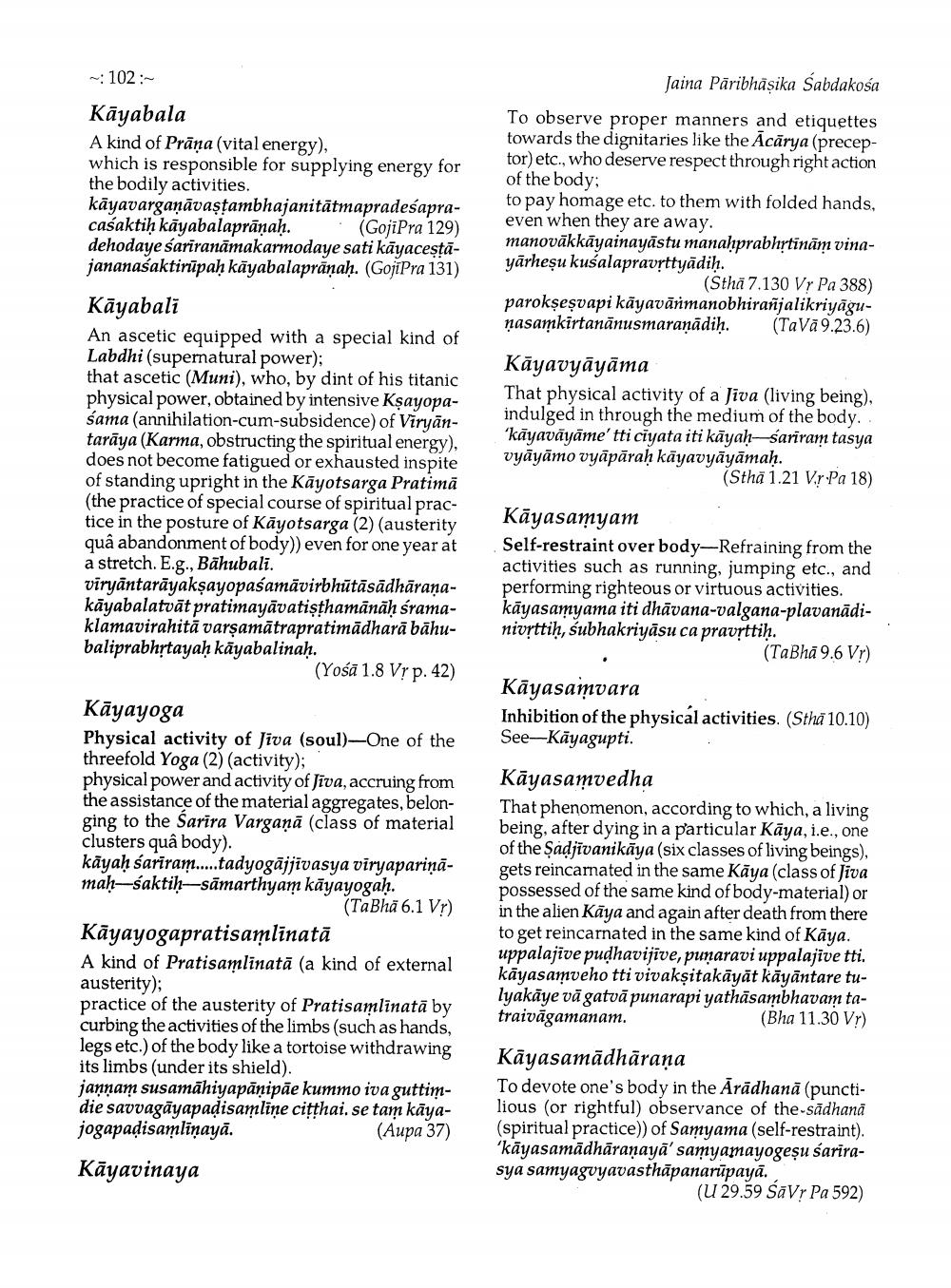________________
102:
Jaina Pāribhāșika sabdakosa
To observe proper manners and etiquettes towards the dignitaries like the Acārya (preceptor) etc., who deserve respect through right action of the body; to pay homage etc. to them with folded hands, even when they are away. manovākkāyainayāstu manahprabhrtinäm vinayārhesu kusalapravrttyādih.
(Sthä 7.130 Vr Pa 388) parokşeşvapi kāyavārmanobhirañjalikriyāgunasamkirtanānusmaraņādih. (Tavā 9.23.6)
Kāyabala A kind of Prāņa (vital energy), which is responsible for supplying energy for the bodily activities. kāyavargaņāvaştambhajanitätmapradeśapracaśaktiḥ kāyabalaprāṇaḥ. (GojiPra 129) dehodaye sariranāmakarmodaye sati kāyaceștājananašaktirūpaḥ kāyabalaprānaḥ. (GojiPra 131) Kāyabali An ascetic equipped with a special kind of Labdhi (supernatural power); that ascetic (Muni), who, by dint of his titanic physical power, obtained by intensive Kşayopasama (annihilation-cum-subsidence) of Viryāntarāya (Karma, obstructing the spiritual energy), does not become fatigued or exhausted inspite of standing upright in the Kāyotsarga Pratimā (the practice of special course of spiritual practice in the posture of Kāyotsarga (2) (austerity quâ abandonment of body)) even for one year at a stretch. E.g., Bahubali. viryāntarāyakşayopašamāvirbhūtāsādhāranakāyabalatvāt pratimayāvatişthamānāḥ śramaklamavirahitā varşamātrapratimādharā bāhubaliprabhịtayaḥ kāyabalinah.
(Yosa 1.8 Vr p. 42)
Kayavyayaтa That physical activity of a Jiva (living being), indulged in through the medium of the body "kāyaväyäme' tti ciyata iti kāyaḥ-sariram tasya vyāyāmo vyāpāraḥ kāyavyāyāmah.
(Stha 1.21 V.r-Pa 18)
Kāyasamyam Self-restraint over body-Refraining from the activities such as running, jumping etc., and performing righteous or virtuous activities. kāyasamyama iti dhāvana-valgana-plavanādinivịttiḥ, śubhakriyāsu ca pravrttiḥ.
(Tabhā 9.6 Vr) Kāyasamvara Inhibition of the physical activities. (Sthā 10.10) See-Kāyagupti.
(TUDI
Kāyayoga Physical activity of Jiva (soul)-One of the threefold Yoga (2) (activity); physical power and activity of Jiva, accruing from the assistance of the material aggregates, belonging to the Sarīra Vargaņā (class of material clusters quâ body). käyaḥ sariram.....tadyogājjivasya viryapariņāmah--saktiḥ—sāmarthyam kāyayogah.
(Tabhä 6.1 Vr) Kāyayogapratisamlinatā A kind of Pratisamlinatā (a kind of external austerity); practice of the austerity of Pratisamlinatā by curbing the activities of the limbs (such as hands, legs etc.) of the body like a tortoise withdrawing its limbs (under its shield). jannam susamāhiyapānipäe kummo iva guttimdie savvagāyapadisamline citthai. se tam kāyajogapadisamlīņayā.
(Aupa 37)
Kāyasamvedha That phenomenon, according to which, a living being, after dying in a particular Kāya, i.e., one of the Sadjivanikāya (six classes of living beings), gets reincarnated in the same Kāya (class of Jiva possessed of the same kind of body-material) or in the alien Kāya and again after death from there to get reincarnated in the same kind of Kāya. uppalajive pudhavijive, punaravi uppalajive tti. kāyasamveho tti vivaksitakāyāt kāyāntare tulyakāye vā gatvā punarapi yathāsambhavam tatraivāgamanam.
(Bha 11.30 Vr)
Kāyasamādhāraņa To devote one's body in the Arādhanā (punctilious (or rightful) observance of the sādhana (spiritual practice)) of Samyama (self-restraint). 'kāyasamädhāraṇayā' samyamayogeșu sarirasya samyagvyavasthāpanarūpayā.
(u 29.59 ŚãVr Pa 592)
Kāyavinaya




